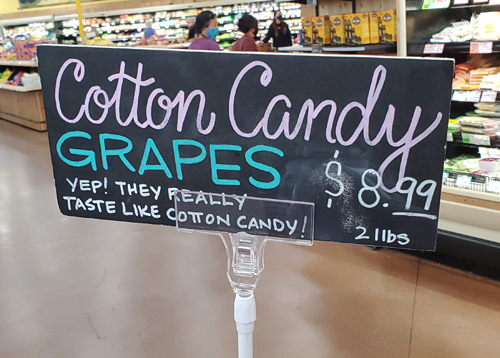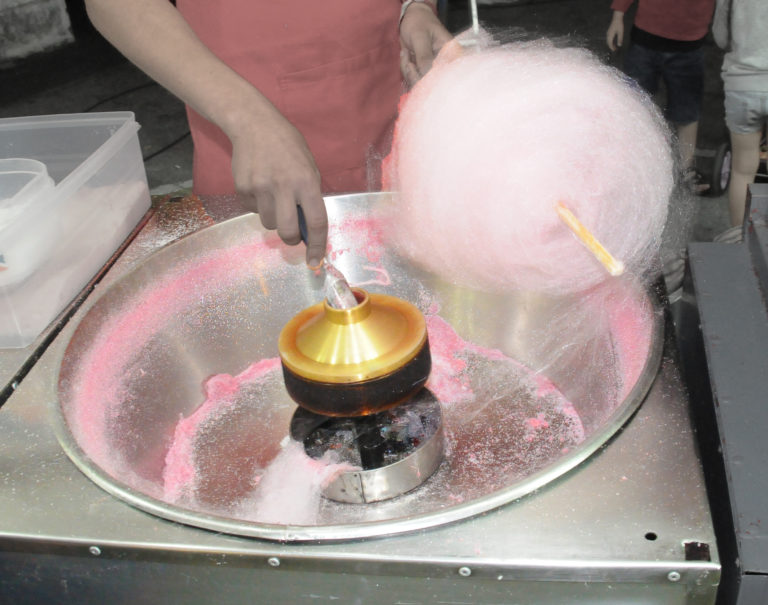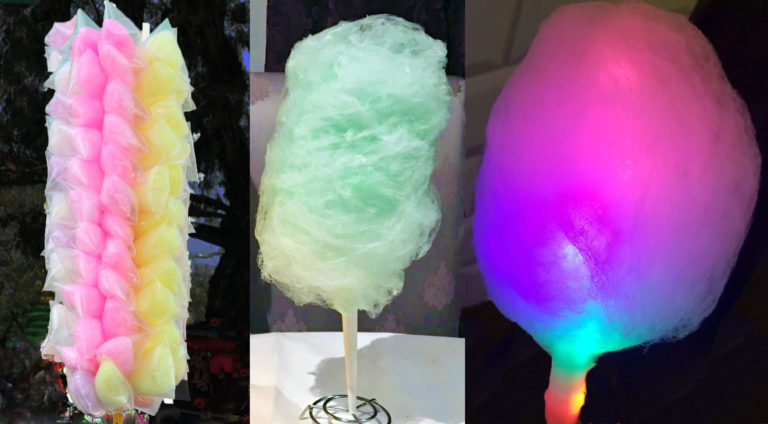
What are Cotton Candy grapes?
Cotton Candy grapes are a unique breed of grapes that look like traditional plump green grapes, but are said taste like the classic cloud-like county fair snack.
These grapes were first made by International Fruit Genetics (IFG) by breeding two grape species and has been available to the public since 2011. Since then, growers have farmed more acres of Cotton Candy in California and started growing it in Peru, Chile, Brazil and Mexico to meet market demand.
Do these grapes actually taste like cotton candy?
Well, it depends on who’s eating the grapes. Generally speaking, yes, they do have a flavor similar to cotton candy. However, it isn’t uncommon to hear a discerning taster say that had they not been told they were eating “Cotton Candy grapes,” they wouldn’t necessarily think of cotton candy as its flavor. It’s the name that primarily causes those that taste the grapes to strongly associate them with the flavor of cotton candy. On the other hand, many stand by the claim that it tastes just like cotton candy. So, it’s really in the eye (or mouth) of the beholder.
Objectively, the flavor of these grapes is mildly sweet with notes of vanilla. This vanilla flavor gives it a surprisingly smooth, nearly tart-less taste. Although the flavor is unlike other grapes, the texture is just like traditional green grapes with a slightly yellowish-green hue. Overall, it is a mellow-tasting fruit with no overpowering flavors or textures.
Are Cotton Candy grapes healthy?
Because these grapes taste similar to cotton candy, it is common to question whether or not they are actually good for your health. As you know, cotton candy itself has no nutritional value as it is simply air-spun sugar. There are many types of cotton candy snacks out there like the cotton candy burrito, cotton candy ice cream cones and other cotton candy dessert combinations. None of those are any good for your health.
However, this type of grape does not contain the ingredients of actual cotton candy and its variations. So, yes they are healthy. Nutritionally, they provide the same health benefits as traditional grapes. They contain antioxidants and flavonoids that help with inflammation, regulate blood sugar and improve brain function.
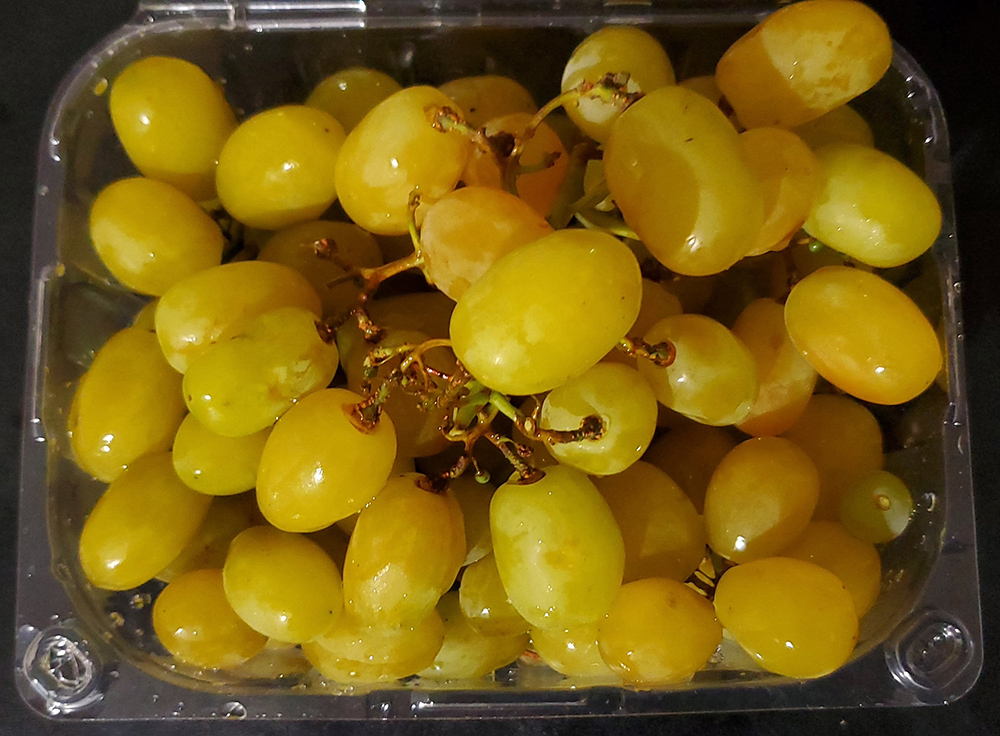
Nutrition Facts (1 cup)
- 100 calories
- 0g fat
- 0mg sodium
- 30g carbohydrates
- 28 net carbs
- 2g fiber
- 28g glucose
- 2g protein
- 0mg iron
- 108mcg vitamin A (12% DV)
- 0mg vitamin C (0% DV)
- 0mg calcium (0% DV)
Do cotton candy-flavored grapes have more sugar?
Although this fruit may taste like candy, it only has 8 grams of sugar per 100 grams of grapes according to NPR. That’s 1 gram of sugar (or 12%) more per serving than traditional grapes.
Are Cotton Candy grapes genetically modified (GMO)?
No, these cotton candy-flavored grapes are not genetically modified.
According to the Non-GMO Project, “A GMO, or genetically modified organism, is a plant, animal, microorganism or other organism whose genetic makeup has been modified in a laboratory using genetic engineering or transgenic technology. This creates combinations of plant, animal, bacterial and virus genes that do not occur in nature or through traditional crossbreeding methods.”
Instead, traditional hybridization techniques have been used with sustainable farming practices to produce this unique tasting fruit. No artificial flavors or genetic engineering is involved. The process of cross-breeding commonly occurs in nature without any laboratory gene extraction.
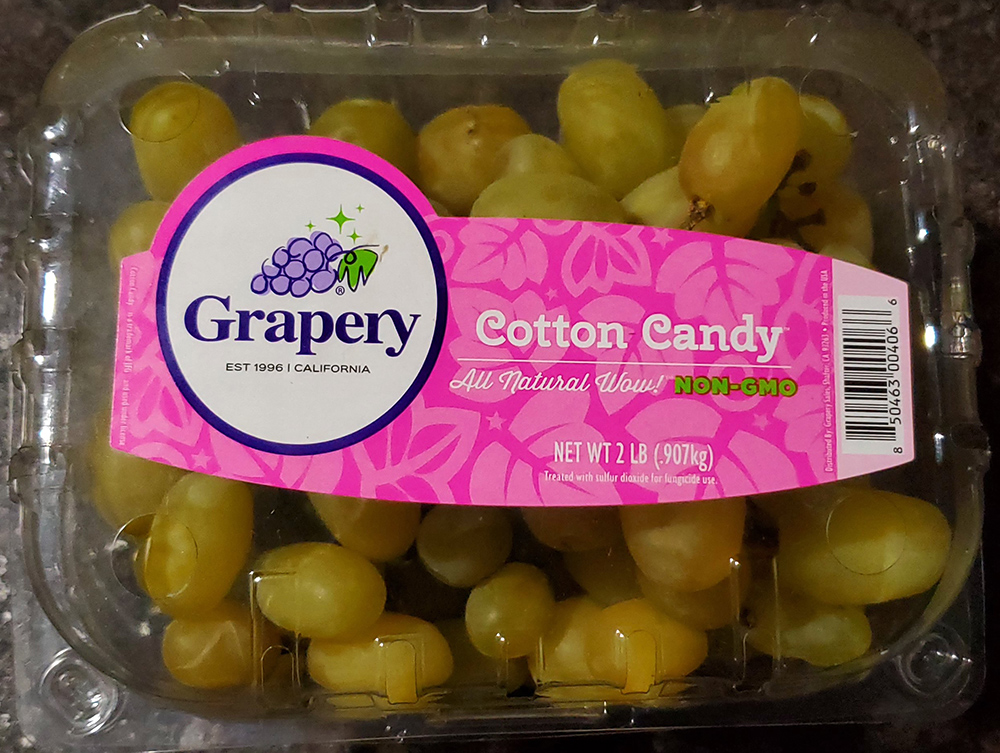
Are Cotton Candy grapes seedless or do they have seeds?
These grapes are grown to be seedless, but like many seedless grapes, they may still have small edible seeds in them. Usually, each grape has one tiny edible seed, which may go unnoticed while eating. For eaters who are sensitive to taste and textures, it is advised that these seeds be removed since they can taste slightly bitter. The texture of the seeds may also be unpleasant for those expecting a completely smooth eating experience. However, these seeds are completely safe for consumption and is not an even issue for most eaters.

Can you grow Cotton Candy grapes from their seeds?
Although it is possible to collect seeds from these grapes and grow grapes from those seeds, it may take a couple of years to find out what the grapes actually taste like; it is a total gamble on whether or not the fruit they bear will turn out to be like the parent vine, or even be edible. The upside to growing your own grapes with seeds is that you may serendipitously discover a new grape variety. However, if you’re specifically looking to grow grapes that taste like cotton candy, the best way to do so is by grafting them from their stems. Unfortunately, this is a difficult process with a low success rate.
If you’re looking to grow your own cotton candy-flavored grapes for commercial use, you’re out of luck. IFG has patented its unique grape hybrids. Also, the term “Cotton Candy” is a registered trademark by IFG, which is why we capitalize it when we specifically refer to these grapes.
How are green grapes made to taste like cotton candy?
This type of green grape has been made through the old fashioned process of cross-breeding two different grape species. The team at International Fruit Genetics did not deliberately seek to make a grape that tasted like cotton candy. Instead, it was a fortuitous find when crossing a west coast grape species with an east coast species. According to the co-founder of International Fruit Genetics, it can take between six and fifteen years to complete the entire process of successfully crossing multiple species of grapes and making it available to the public.
Who produces these grapes?
The most prominent grape makers that produce this cotton candy flavor created by IFG include:
- Grapery
- Molina Group
- Doce Uva (Peru)
- Moyca (Spain)
Is there a wine that tastes like cotton candy?
You may be wondering, “Well, if they can make grapes that taste like cotton candy, can’t they make wine that tastes like it too?”
Yes, there is a wine that exists containing hints of cotton candy made by Urban Vines. It’s called Carnival Candy. The grapes used in their wine have a natural cotton candy flavor.
Where can I get Cotton Candy grapes?
You can find these sweet green grapes in produce markets seasonally—usually in August and September in the US, but imported grapes have been seen in stores as early as mid-spring all the way through late September. In Mexico, they are typically sold from April to June. While in South America, they are available between December and March.
You can get them shipped directly to you from online shops like GreatPlentifulShopCA on Etsy here.
Additionally, they are available at many large chain supermarkets and grocery sections of big-box stores. Here’s a list of retailers that sell them. (Tip: call your nearest location to make sure they are in stock)
- City Market
- Costco
- Dillons
- Fred Meyer
- Fry’s Food Stores
- Giant
- Harmons
- Harris Teeter
- Kroger
- Lowes Foods
- Lucky’s Market
- Mariano’s
- Meijer
- Pay Less
- Piggly Wiggly
- Publix
- QFC
- Ralph’s
- Ruler Foods
- Sam’s Club
- ShopRite
- Smith’s
- Sprouts
- Target
- Trader Joe’s
- Walmart
- Wegmans
- Whole Foods
- WinCo
- Winn-Dixie
How much are they?
The price of Cotton Candy grapes has gone up with the demand over the years since it was first available to the public in the early 2010s. In stores, they are usually sold anywhere between $3-5 per pound. If you buy them online, prices can range between $30-80 for several pounds.
